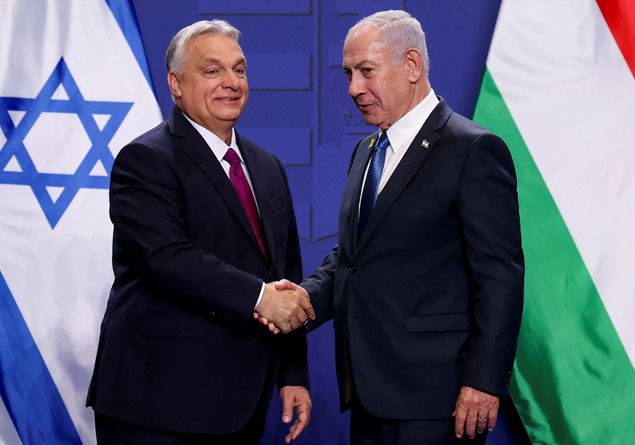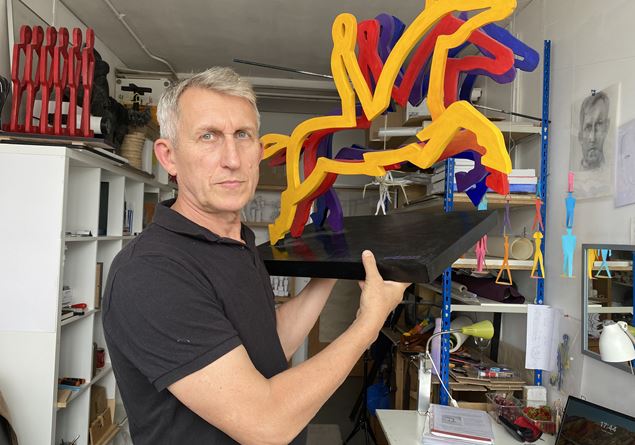The sculptor Oleksandr Lidahovskyi.
by Valentyna Bilan
“Through art, I tell the world that Ukraine is not a local conflict.” Ukrainian cultural diplomacy in action during the war. Sculptor Oleksandr Lidahovskyi, known to Kiev residents for his sculptures in Shevchenko Park, Pechersk and Landscape Alley, continues to create even in war. Although his studio and all his possessions were destroyed by a Russian grenade, he found the strength to carry on and work in the most prestigious artistic venues in the world, incisively representing Ukrainian culture. His artistic talent was highly appreciated and, chosen from hundreds of participants, he was invited to the Lucca Cartasia Biennial (Lucca, Italy). Lidahovskyi is currently working on a steel sculpture in England and plans to talk about the war in Ukraine in the language of art, both in Britain and in Europe. We will talk about this in our interview.
– Oleksandr, tell us about your project at the Biennale Cartasia in Lucca, after a month of hard work in the sultry heat of Italy. How did your colleagues and admirers evaluate your work?
«It was a successful performance on the international stage. Participating in this festival was a source of great satisfaction for me because my project was selected among 500 high-level artists. I am happy that my colleagues and sculpture enthusiasts really appreciated my work. I think I’ve done something that no one else has done, both in terms of technique and visualization of the idea. It is a very significant and important work for me. I had a month to make the sculpture. It’s nice that, And while I was working it was nice to see people who occasionally tried to look out into the pavilion to observe the manufacturing process and express their positive impressions. I perceived it very well. Even when I came home in the evening after a hard day at work, people stopped me and expressed their admiration.”
– What inspired you to create the sculpture “The Flight of the Swallow”?
«Every artist is a creator. And even though he doesn’t live in Ukraine, he is deeply influenced by what is happening in my country. The theme of the Biennial reflected the present, the future and the past. I tried to embody an idea that literally shows our Ukrainian characteristic: openness to the future. In the West, I think, people are stuck in the eternal postmodern present. They are afraid of the future. But we no longer have anything to fear, because we are at war and there is nothing older than war. We place all our hopes in the future. The image of the sculpture is multilayered, it reflects all these aspects in its 5 meters.”
– How is “The Flight of the Swallow” a personal project for you?
«It’s true, “The Flight of the Swallow” is a very personal work for me. My thoughts on the here and now are embodied in this sculpture. Some time before I felt that war was coming – which took away not only my present and future, but also my past – but I did not share this collective fear of the future. My sculpture is a girl standing, in a swallow position, looking forward. One of his feet is in the past, the other in the present and his arms welcome the horizon as if it were the border between past and future. From below, the five meter high figure looks like a cross: it is our crucifixion in this eternal and present. It is about the limitations of the old world, the need for rebirth and transformation. And the future is already at our doors. In our works we only talk about us, about what is happening in Ukraine: this is how we artists show ourselves to the world. Therefore, with our works, we show ourselves not as poor, refugees, victims, but as active people who continue to work despite all the difficulties they face.”
– His laboratory was destroyed at the beginning of the war. How did this tragic accident affect your work?
«It was a hard blow. All my works, tools, materials, everything was destroyed. At first it was a shock and I was desperate, but then I realized that I had to move on. Emigration has become a second life for me, the loss a sort of purification. I realized that I could start all over again, recover and create something new. This process of rebirth is very important to me as an artist. It allowed me to rethink my values and my approach to creativity.”
– How did moving to London affect your life and career?
«Moving to London was a forced decision, but my family – my wife Dasha Nepochatova and daughter – adapted to the new environment. This city has offered me new opportunities for development and cooperation. I was able to work with new materials and broaden my horizons. I was elected an honorary member of the Royal Society of British Artists. It was a great recognition for me as an artist, especially in such a difficult time. I was pleasantly surprised that my recognition was widely publicized in the British press (The Guardian, The Times, The Independent and more than 900 other British publications).”
– How can artists talk about the war in Ukraine on international platforms and keep the war at the center of international attention?
«For artists living abroad, their work reflects the specificity of the fact that the war in Ukraine affects each of us. When I heard about the war when I was young, it didn’t affect everyone like it does today. It was all very far away. When you are in the cultural mainstream of Europe, when you are visible and communicating on international platforms, when you are in dialogue with the world, then you create concrete situations with your work. This is not about someone being bombed in Kiev, but about my two children, my granddaughter, my family, my acquaintances and friends. I have always believed that art should transcend nationalities and borders. This award was confirmation that my work resonates with people all over the world and gave me extra motivation to continue working and creating new projects. I have therefore presented my works in numerous international exhibitions, including the London Winter Sculpture Park.”
– Can you tell us about your plans and mission to work in the field of cultural diplomacy in the UK?
«I am currently preparing a steel sculpture in Great Yarmouth, England. This sculpture echoes my work of the same name in Pechersk, Kiev. It is a seven meter high steel figure, called the Tightrope Walker, which symbolizes the unstable balance in every person’s life. The tightrope walker always walks a thin line, maintaining balance with concentration. This image reflects well the modern reality in which we all try to find stability and confidence in the future.”
– You are known for your works made with different materials, including paper, steel and bronze. How do you choose the material for your works and how does it influence your creative process?
«Material has always been an important part of my creative process. I started with sculpture on paper. I didn’t have the possibility to buy materials and tools, I didn’t have a laboratory. What I could afford – a table, a sheet of paper, a knife and some glue – was the bare minimum. Even when I had the opportunity to work with bronze and steel, I started with paper models. Paper is an economical and flexible material that allows you to experiment and quickly realize ideas. Steel and bronze offer greater opportunities for large-scale projects and allow you to create works that can withstand the effects of the environment. The choice of material depends on the idea I want to convey. Each material has its own characteristics and possibilities, and it is always an exciting process to find new ways to use them.”
– Tell us about your new project, Horsemen of the Apocalypse. What inspired you in this idea?
«The idea for the Horsemen of the Apocalypse project was born as a reaction to the war in Ukraine. Biblical texts often convey some algorithms based on identifying and understanding cause and effect relationships. These algorithms, embodied in the form of metaphors, have described and continue to describe our reality, its tendencies and its internal logic. The Horsemen of the Apocalypse are allegories of plague, war, famine and death. This metaphor rhymes with the world events of recent years in a strange way, revealing some directions and sequences of development of these events. The war in Ukraine, which the world still inertially perceives as local, is actually the beginning of a process that is developing much more rapidly. “Horsemen of the Apocalypse” is conceived as a sort of transversal project, a viral message, like a line of a semantic spiral that twists into contemporary reality. It will be a sculpture with a viral warning message, which will show the historical algorithms of events that are happening to Ukrainians in the language of plastic. The significance of this work is that it connects our events in Ukraine with the world. The negotiation process is ongoing and we will present the sculpture in public spaces across Britain and Europe. It will remind democratic countries of the consequences that can occur if they do not come to their senses in time and do not support Ukraine.”








